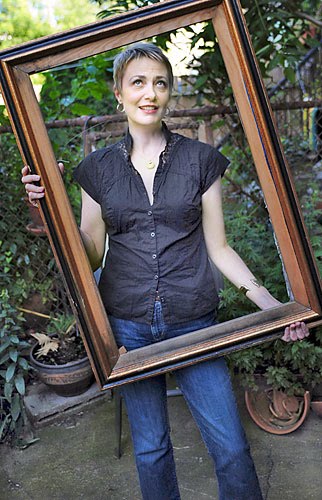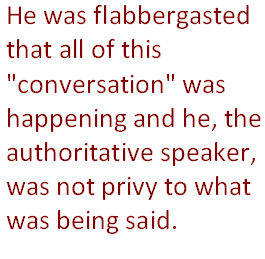Sharon Mesmer, 'I Accidentally Ate Some Chicken and Now I'm in Love with Harry Whittington'
LISTEN TO THE SHOW
 Kenneth Goldsmith, Nada Gordon and Steve McLaughlin gathered in Al’s office/recording studio at the Kelly Writers House to talk about Sharon Mesmer’s flarfy gem, “I Accidentally Ate Some Chicken and Now I'm in Love with Harry Whittington.”
Kenneth Goldsmith, Nada Gordon and Steve McLaughlin gathered in Al’s office/recording studio at the Kelly Writers House to talk about Sharon Mesmer’s flarfy gem, “I Accidentally Ate Some Chicken and Now I'm in Love with Harry Whittington.”
The recording we used was made at the Writers House in February of 2007, at a mini Flarf Poetry Festival organized by our own Steve McLaughlin. We’re pretty sure that the poem was first posted to the flarflist – a listserv of flarf practitioners (and a few nonpracticing advocates) that serves as a medium for trying out all sorts of improvisational and quasi-improvisational poetic “bottom-feeding” (to use Kenny G.’s positive phrase). Is flarf poetic, non-poetic or anti-poetic, or, anyway, what combination is it of those three? That turns out to be the crux of our discussion. What “poetic” elements and devices does Mesmer retain and employ, and to what effect? Gary Sullivan originally defined flarf writing as, among other things, “corrosive,” and when Al asks the group whether Mesmer’s poem is corrosive, a fascinating discussion ensues: in part, we seem to move away from Sullivan’s notion. And since this is a poem, at least at first (at least superficially [superficially?!]) about Harry Whittington, the man Dick Cheney shot during a boondoggling hunting trip in Texas, it seems reasonable to ask about the political meaning or import of the piece.
The answer is hardly straightforward. At one point Steve pulls out the smoking gun (as it were), proving that Sharon Mesmer took most of the poem verbatim from Internet sources. And what about taste? Al puts it straight to Kenny, who has sometimes argued that one conceptual work is effective, while another work is not--the key being, the quality of choice of of concept. So what, Al asks, is the role of aesthetic distinction and valuation? Nada adds some possibly quite relevant biographical information, so we are led to ponder: What does Mesmer’s family of blood-on-apron butchers and her own principled vegetarianism have to do with the politics of the poem – its critique of a culture in which everything, actually and figuratively, tastes like chicken? It is, of course, a culture that includes this poem and makes it entirely (and specifically) possible.Here is Sharon Mesmer's PennSound author page, and here is a direct link to a recording of the poem. Here is a link to one of Mesmer's internet sources.
June 21, 2010
Bodies in classroom
Goldsmith on pedagogy
Years ago Jim O'Donnell - a pioneer in internet-age teaching - said that the role of the teacher would change from that of provider of knowledge... to that of "front end to the universe": from be-all/there-all giver in a room full of receivers and final arbiter of what constitutes relevant knowledge to medium or gateway or traffic cop gently guiding but never blocking the learners' pathways outward to a world of information and knowledge and text that made the teacher a speck on the horizon yet still great in importance if she or he would thrive in the role of medium. Not maker or giver of the medium, but medium itself. There are classrooms today (and it has not much to do with computing hardware available, though a minimum is required...namely a good wireless connection for everyone) in which the new role is possible and the teacher loves playing it. From time to time here I have mentioned Kenneth Goldsmith's teaching, in part because I adore what Kenny does and in large part because I happen to have access to it, a close look at its development. Kenny's artwork did all this before he taught regularly, but now the pedagogy is catching up with the rest of the project. Here are a few paragraphs Kenny sent me not long ago about what the hell is happening in his classroom:
During a recent classroom visit of a visual artist, it occurred to me that we've reached a new paradigm in radical pedagogy. The artist entered the room, greeted the class and began his lecture with a PowerPoint presentation about his work. While he was speaking, he noticed that the class -- all of whom had their laptops open and connected to the internet -- were furiously typing away. He flattered himself that, in the traditional manner, the students were taking copious notes on his lecture, devouring every word he spoke. But what he was not aware of was that the students were engaged in a simultaneous electronic dialogue with each other about what the artist was saying, all played out over the class listserv, which they all had instant access to. During the course of the artist's lecture, dozens of emails, links and photos were blazing back and forth to each other; each email elicited yet more commentary and gloss on the prior emails to the point where what the artist was saying was merely a jumping off point to an investigation of such depth and complexity, that the artist -- or any ideal of traditional pedagogy -- would never have achieved. It was an unsurpassed form of student's active and participatory engagement, but went far astray from what the speaker had in mind.
During the course of the artist's lecture, dozens of emails, links and photos were blazing back and forth to each other; each email elicited yet more commentary and gloss on the prior emails to the point where what the artist was saying was merely a jumping off point to an investigation of such depth and complexity, that the artist -- or any ideal of traditional pedagogy -- would never have achieved. It was an unsurpassed form of student's active and participatory engagement, but went far astray from what the speaker had in mind.
When later told about this, the artist was very disturbed. His ego was mauled and when shown the blizzard of gloss, was more dispirited as he felt much of what had transpired was irrelevant and even irreverent (hastily Photoshopped detournments of images and concepts he brought up). He was flabbergasted that all of this "conversation" was happening and he, the authoritative speaker, was not privy to what was being said.